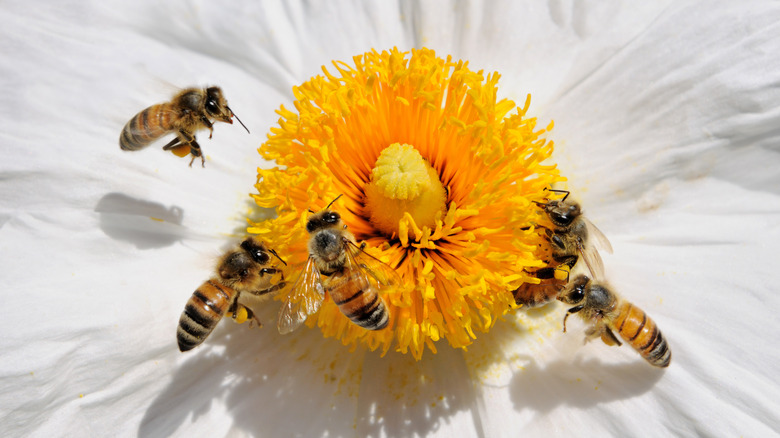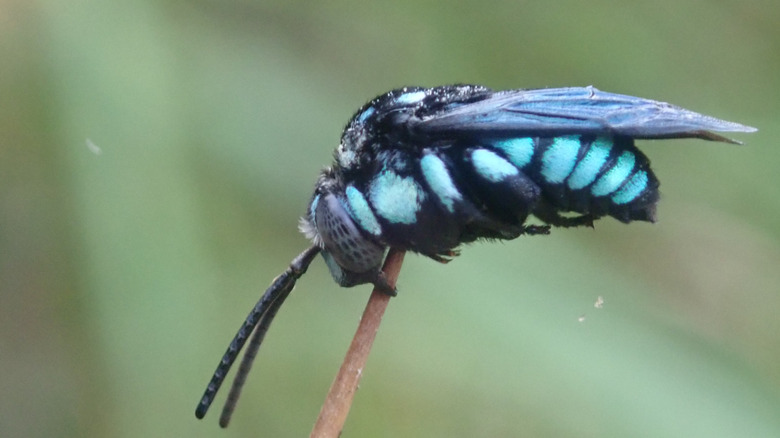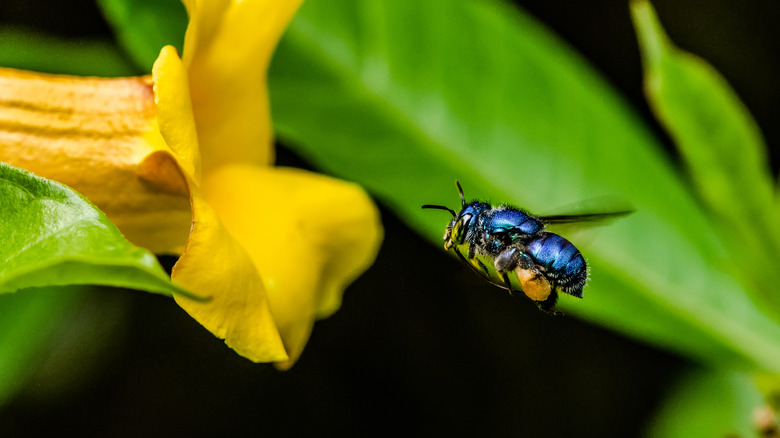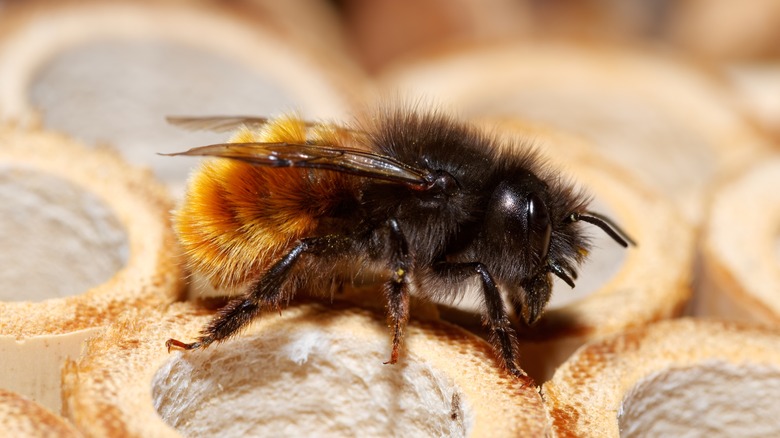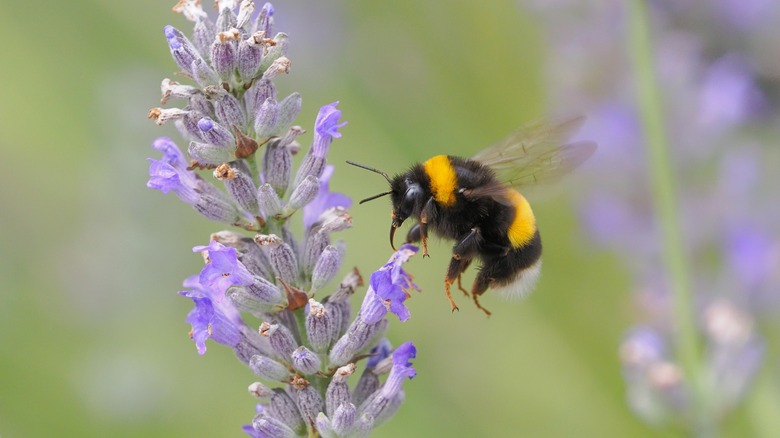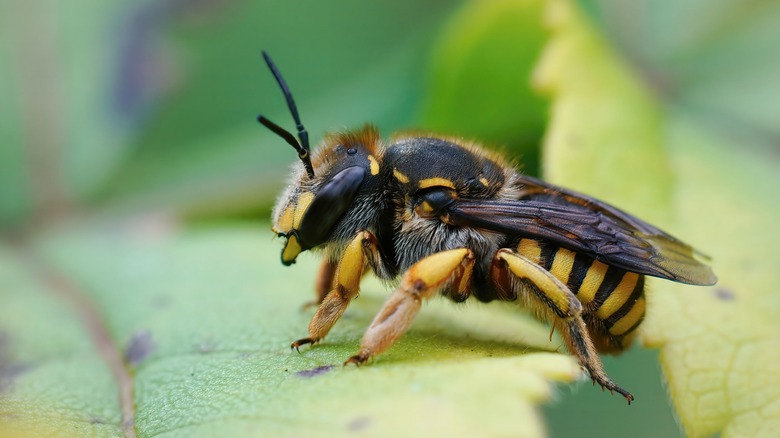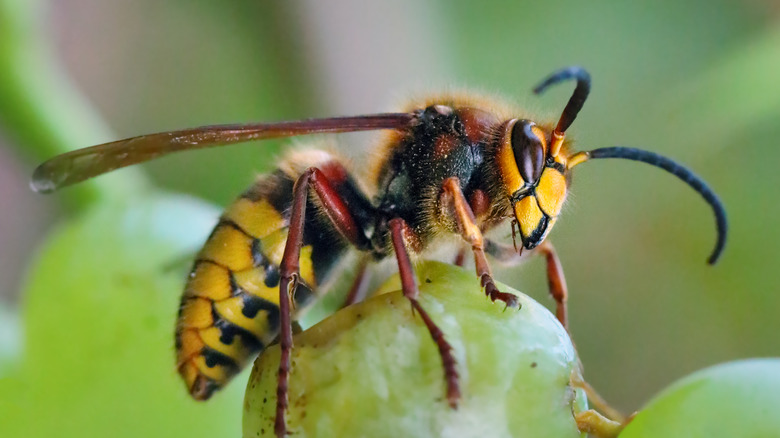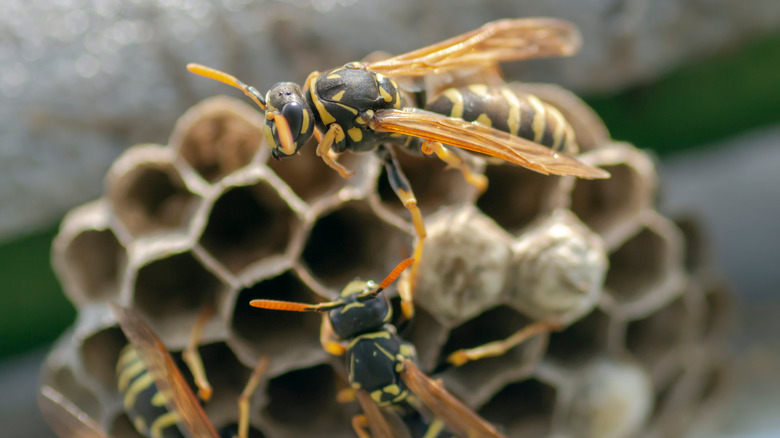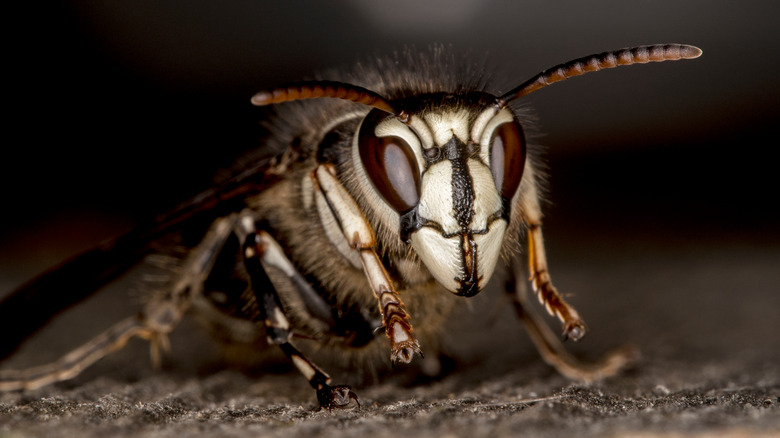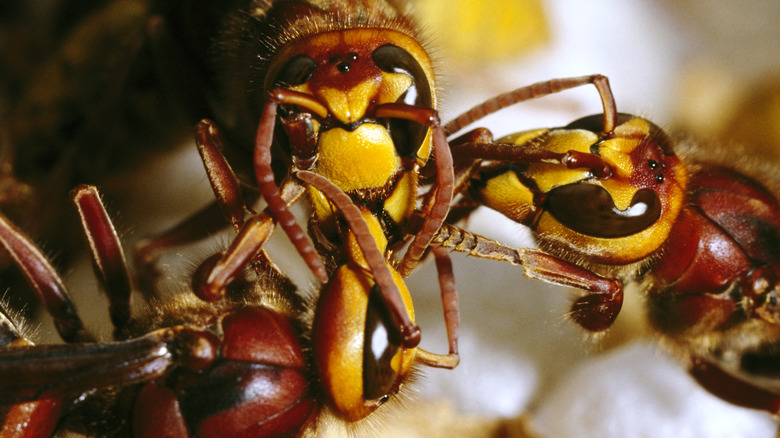17 Types Of Bees, Ranked By Danger Level
The nature of a bee's danger depends upon who you ask. For those who keep them and process their delicious honey, bees are more friend than foe. In fact, there are many who think we are more of a danger to bees than they are to us. However, for those who are allergic to their sting, all bees have the potential to be dangerous. And, as is the same with wolves, bears, and spiders, there are some bees that are more dangerous than others.
According to the USGS, over 20,000 species of these pollinators buzz around the world. From the plains of Africa to the mountainsides of Nepal, Earth's bees have been able to adapt to a multitude of climates, ecosystems, and threats. As such, they have developed either tame or tempered attitudes towards people.
While the vast majority of bees will not attack unless provoked, their defense mechanisms still pose some danger to people. No one wants to get stung by a bee, and even fewer want to be stung more than once. Our ranking, which goes from least to most dangerous, takes aggression, stinging pain, and fatalities into consideration. We're not going over all 20,000 species. That'd take forever. Instead, we've narrowed it down to 17. These are the bees you'll find buzzing in your garden or trying to invade your picnic. So, keep an eye out.
17. Cuckoo bee
Similar to wasps in their shape and relatively hairless bodies, cuckoo bees (Ericrocis Lata) are distinctive due to their vibrant coloration. Stripped in black and light blue, the cuckoo bee's aggression tends less towards humans and more towards other bees. They are relatively timid around people, which is why they are the first on this list. cuckoo bees do not present any benefits in terms of pollination or nectar production. They are what's known as parasitic bees, which we'll explain shortly.
As far as stings go, the cuckoo bee has perhaps the weakest sting in the entire bee kingdom. It's certainly noticeable, but it doesn't cause any more pain than a good pinch, like the kind you used to get from grandma when she came to visit. The pain doesn't last, either. Any sting from a cuckoo will vanish within a few minutes.
Cuckoo bees also won't sting unless they are provoked or feel threatened. Since they avoid contact with people, this treat usually comes in the form of other bees. The cuckoo responds to this threat by laying its eggs among those of its rivals. Thanks to their parasitic nature, the cuckoo larvae will eat the host larvae, as well as any pollen or nectar the mother bee has collected. Such is their way, but it doesn't make it any nicer to hear about.
16. White-faced bee
A member of the Apidae family, which includes honey bees and bumblebees, white-faced bees (Habropoda pallida) are common to both North and Central America and inhabit diverse environments like woodlands, meadows, and vegetable gardens. Noted for their decent size, fluffy appearance, and characteristic white markings, the white-faced bee is one that usually leaves well enough alone. They are often unfairly mistaken for bald-faced hornets, which, as we'll see, do not leave well enough alone.
As such, white-faced bees do not present much danger to people. That is, of course, unless it is provoked into stinging someone. If this happens, the pain from the sting will barely register. Like the cuckoo bee, the sting of a white-faced bee is not all that powerful. However, unlike the cuckoo bee, a white-faced bee sting can leave behind a prickling sensation at the sting site that lasts for several minutes.
Unlike other bees, the white-faced bee is a solitary bee, preferring to build its nest by burrowing into the ground, or in tunnels that have already been dug by other insects. It's very wasp-like in this respect. The benefit of it being solitary bees is that white-faced bees don't gang up on anything they are stinging. This means that if you get stung, it is one and done.
15. Furrow bee
Defined by their large bodies, and long legs that can collect exorbitant amounts of pollen, furrow bees (Halictidae) can be found all around the world in places ranging from the Green Mountains of Vermont, to the wild of the Australian outback. Furrow bees do not pose any particular threat to people, as they are far too busy collecting pollen and eating nectar to pay much attention. This does not mean, however, that they won't buckle down when push comes to shove.
Despite being relatively tame around people, if you attempt to hold a furrow bee or keep it from reaching the plants it wants to feed on, you will be in for a nasty little sting. It's not very powerful, but it is certainly noticeable. Swelling might occur at the sting sight, but this is rare. More often than not, the pain will subside quickly, and no swelling will occur.
However, according to the Australian Museum, there has been one reported case of death as the result of a furrow bee sting. The person in question had an extreme sensitivity to bee stings and died of anaphylactic shock. So, furrow bees are not without their dangers, which is why you should always bee (pun intended) wary of any you may encounter.
14. Squash bee
Squash bees (Peponapis pruinosa) have a very special job. They are experts at pollinating squashes and gourds, meaning that they will thrive on farms and home vegetable patches. This speciality requires that the bees be small enough to fit inside a blooming squash blossom in order to collect the pollen. As far as their shape goes, squash bees resemble a large bumblebee, and they also don't have stingers. Instead, squash bees bite.
Since bee bites do not carry with them the type of venom commonly found in a stinger, the bite of a squash bee is not going to pass along any toxins that may cause swelling. Instead, the bite is just going to be quick and rather painful. Though not overly powerful, squash bee bites can leave behind a burning sensation that will, thankfully, vanish after a short period of time.
These bees are very active during the spring and summer, so you can expect to find them in your garden. Like their bumblebee cousins, they are rather friendly and will certainly not bother you if you don't bother them. However, if you're making fried squash blossoms, check inside the flowers for bees. The last thing you want is to bite down on a dead squash bee you inadvertently cooked.
13. Orchid bee
Found primarily in Central America and the U.S. state of Florida, the orchid bee (Euglossa viridissima) is another solitary bee that specializes in pollinating orchids and feeding on their nectar. These bees do not create honey but instead rely upon their vibrant colors and the scents they concoct to attract mates. Each male orchid bee uses the nectar of the orchid flower to create its own unique musk. They will then buzz around until they find a suitable mate. They are essential rainforest pollinators and prefer to keep to themselves and their flowers.
As far as stinging is concerned, you really only need to worry about female orchid bees. Like certain dangerous snakes who don't like to bite in order to preserve their venom, female orchid bees are not overly fond of using their stingers. They will hesitate as long as they can. When they do sting, it isn't anything to write home about. It hurts, for sure, but it's not any more painful than stubbing your toe.
However, one unique thing about orchid bees is that they can sting multiple times. While some bees can sting only once, orchid bees can continue to sting without causing themselves harm. So, one mildly painful sting could soon turn into multiple if the female orchid bee is sufficiently ticked. These occurrences are rare, however. Just don't mess with their flowers, and you should be good to go.
12. Sweat bee
We're now getting to the types of bees that can cause a lot more aggravation and pain, should you happen to cross them, starting with the sweat bee (Halictidae spp.). These bees tend to seem far more aggressive than they actually are. This is thanks to the fact that they are attracted to perspiration, which is how they get their name. So, if you're out on a hot day, sweating away in your garden, there is a good chance you'll be set upon by some sweat bees. They aren't there to sting you, however. They just like your sweat.
The irony is that, more often than not, the attraction sweat bees have to sweat is what causes them to sting, which, like orchid bees, is not something they are overly fond of doing. They will view your attempts to swat them away as an attack and will sting you in retaliation. However, the blessing is that their stings are only mild, and they will not sting you more than once.
So, even though sweat bees can be annoying, it's better not to brush them off or swat them away if you know they are what's crawling on you. You can typically identify a sweat bee by its smaller size and vibrant green face. They are just there to say hello. Try to return them with the same courtesy.
11. Mason bee
As their name suggests, mason bees (Osmia) like to construct their nests out of mud and dirt. A much-beloved pollinator, one that is 120 times more effective than a honey bee (via Organic Control), these insects have a wide application of uses in agriculture and fruit orchards. They can be housed in special cocoons, which they fill with their mud and dirt to provide extra protection. They are solitary bees, which means that they're relatively chill around people because they aren't protecting a territory.
This means that mason bees are not likely to sting you if you aren't bothering them. And they do need to be sufficiently bothered to be provoked enough to sting. When the sting does occur, it is on the more painful side. Like other species of bees, it is only the females who sting. They provide a good stabbing sensation, which can welt and remain sore for several hours. Most orchard workers have been stung after one mason bee becomes trapped underneath a layer of clothing.
Despite this more intense sting, the benefits of the mason bee outweigh any downsides. Though you're not going to be getting any honey out of the deal, the pollinating mason bees do to gardens and orchards is second to none.
10. Bumblebee
Among the most beneficial insects you'll find anywhere, the bumblebee (Bombus) is the most recognizable bee on this list. With their large, puffy bodies and overall friendly demeanor, bumblebees are easily one of the world's favorite bees. Though their pollinating efforts might not be as effective as the mason bee, bumblebees provide wonderful amounts of pollination that are going to keep your garden and wider ecosystem extremely healthy.
This beneficial behavior does not come without its drawbacks, however. Despite being known as a more friendly bee, if you threaten or provoke bumblebees in any way, they are going to sting you. And this sting is the most powerful we've seen on this list so far. The sting of a female bumblebee is rather intense, and the affected area will turn red, swell, and remain burning sometimes for several days. As bumblebees are social bees too, there is a chance you'll be dealing with more than one stinging you at a time.
Bumblebees can also sting multiple times, making them an especially formidable foe. Those with allergies should be cautious around bumblebees, especially if their hive is nearby.
9. Honey bee
Honey bees (Apis mellifera) are our friends. They are so much our friends that thousands of people build the bees' homes and collect the honey that they make. Enormously beneficial in terms of plant health, honey bees make for great pollinators to have in your garden. However, due to their status as a social bee and the need to protect their hive and queen, female honey bees — which are the only ones equipped with stingers — can be particularly aggressive when threatened.
You are seldom just dealing with one honey bee when they decide to sting. Their social status means that you're often dealing with many at a time. Honey bee stings are potent enough to send allergic people into severe anaphylaxis, which always requires immediate medical attention. As far as pain goes, honey bee stings can be quite painful. They shoot through like lightning, causing burning sensations that can last several hours. The resulting swelling from the venom injected can last a few days.
Despite their typically docile temperament, honey bees can get aggressive when threatened. Unless you know how to handle them properly, it is best to just leave them to their business of collecting pollen and making honey. It takes roughly 500 stings to kill an adult human, per the USDA.
8. Carpenter bee
An unwelcome guest for anyone who owns a wooden house, carpenter bees (Xylocopa spp.) have a proclivity for burrowing into the frames and foundations of homes, which can cause lasting damage if not treated right away. Not only that, but carpenter bees do not have the sunny disposition of some of the other bees on this list. They tend to be very aggressive and territorial. However, this behavior is usually a bluff to try and scare people and other animals away. Yet, when they are threatened enough, they will come out and sting you.
Again, only the female carpenter bees are equipped with stingers. The males are typically the ones who will buzz around and show this bluffing behavior. The females will sting, however, if they do feel sufficiently threatened. The sting they leave behind is sharp and fiery. The pain is relatively brief, typically not lasting much longer than a few minutes.
So, while they might be more showy in their aggression, carpenter bee threats typically don't lead anywhere. You're more likely to have a problem with the ones that have set up shop in your attic before than they are to have a problem with you.
7. Wool carder bee
Native to mainland Europe, the United Kingdom, and Ireland, wool carder bees (Anthidium manicatum) derive their name from the fact that the female bees comb fibers from plants to construct their nests. Proper wool carding is the process by which loose wool fibers are untangled and pointing in the same direction. This is necessary in order to create yarn. Carder bees are not typically aggressive unless anything approaches their nests or flowers. Then, they are on the attack.
Now, we've mentioned that it is primarily the females of the bee kingdom that have stingers, and this is the case for carder bees, too. However, males aren't mere show-offs in this case. The male wool carder bees have spikes on their legs, which they use to poke and prod their foe painfully. When females join the fray, the stingers come out. The sting is not overly painful, but it can leave a decent burning at the sting sight, which lasts for several hours.
Though the wool carder bees present a two-front attack, they are generally docile around people. Their main opponents are usually honey bees, which the carder males kill in order to get at the pollen and nectar of a plant they want. Introduced to North America in the 1960s, European wool carder bees are among the more aggravating invasive species because of the danger they pose to native bee populations (via UCANR).
6. Yellowjacket
Now we come to the stings that really hurt, and we start with everyone's not-so-favorite picnic guest, the yellowjacket (Vespula maculifrons). Yes, yellowjackets are technically a type of wasp, but seeing as so many people lump these stinging insects together into one category, it's appropriate that we do the same with this list. Yellowjackets make their nests in the ground and defend them fiercely. They are also very attracted to sugars, which is one of the reasons they are so common at outdoor barbecues and picnics.
According to the Maine State Government, yellowjackets account for roughly half of all bee stings sustained in the United States in a given year. This makes sense, as yellowjackets are highly common and will sting without much cause. And these stings hurt. They can cause severe burning and pain that can last upwards of two hours. The redness and swelling that follows can last for up to a week if the sting is deep enough.
You'll most likely have an issue with these guys during the summer and spring. The nests and yellowjackets will die off during the fall. Unfortunately, short of using insecticide or liberal amounts of garlic to repel them, there is not much you can do to ward off yellowjackets.
5. Eastern cicada killer
The Eastern cicada killer wasp (Sphecius speciosus) is about as unwelcome a sight in your backyard as a bluejay is at the bird feeder. Among the most scary looking of all insects, the Eastern Cicada killer is actually not outwardly aggressive to humans. As its name suggests, these wasps are primarily concerned with killing and eating cicadas, which are large, aggravating insects in their own right. However, just because Cicada killers don't go after people doesn't mean that they can't.
This is the common paradox with dangerous animals. The more scary and dangerous their capability, the more timid they tend to be. However, if they do decide to attack, you're gonna be in trouble. Such is the case with the Eastern Cicada killer. Their sting, which again only the females possess, causes extreme pain. The burning will last for a few hours, though once it's waned, that's it. There is no lasting swelling or aftereffects.
One thing Cicada killers are particularly good at is wrecking a lawn. Though there are many myths that come with lawn care, brushing off the damage these insects can do is not one of them. Cicada killers can wreak havoc on your lawn thanks to their tendencies to burrow. Thick, well-maintained turf is the best way to deter these wasps.
4. Paper wasp
Paper wasps (Polistes dominula) are another scary-looking creature that is actually relatively non-aggressive towards people. You'll recognize the presence of paper wasps thanks to their distinctive nests. They look like round balls of papier-mâché, only they are filled with hexagonal cavities for the paper wasps to nest in. This material used is actually chewed wood, which is typically taken from wherever they are building the nest.
Though they do not do it often, a paper wasp will sting when it feels sufficiently threatened by a person or other animal. They can be very painful and cause the same kind of allergic reactions that other bees can cause. This makes them deadly if they sting the right person. The area will become red and swollen and will continue to grow inflamed if it is not dealt with immediately.
Overall, the paper wasp is a relatively peaceful garden visitor. They will feed on nectar alongside honey bees, and will readily devour any garden pests they find in the yard. So, in many ways, despite the pain and potential harm they can cause, they are more friend than foe.
3. Bald-faced hornet
The same cannot be said for the bald-faced hornet. These hornets are as scary as they look, and they look pretty scary. Pale white with long antennae and large abdomens equipped with stingers, the bald-faced hornet is a social creature, meaning that it lives in large hives of its kind. Therefore, as is common among social stinging insects, they can be very aggressive when it comes to people and animals around their territory. They will sting without much cause, and what goes along with said sting is scary.
Similar to the bite and venom injected by a snake, the sting and venom of the bald-faced hornet are particularly painful and potent. Not only is the sting itself incredibly painful, attacking nerve endings and spreading out from the sting site, but the venom can cause some pretty serious aftereffects. These include intense swelling, difficulty breathing, and accelerated pulse. The latter two are not dissimilar from a heart attack.
What stinks is that where there is one bald-faced hornet, there are likely hundreds more. Their nests can grow to enormous sizes and house hundreds, if not thousands, of other hornets. This is one nest you literally should not kick.
2. European hornet
Introduced to the United States in 1840, 21 years before the American Civil War, European hornets (Vespa crabro) have been a thorn in this country's side for nearly 200 years. Large hornets with smooth bodies and long stingers, the European hornet is not like the mild-mannered honeybees or even the pleasant garden paper wasps. They are mean, large, social, and extremely aggressive.
And their stings are the stuff of nightmares. Hornet stings are typically more powerfully painful than those of the wasp or honey bee because of the toxicity of their venom. The European hornet's sting is about as painful as that of a honeybee, but it can leave behind more severe aftereffects, especially if the person stung is allergic. European hornets can also sting multiple times, which means they can cause a lot more damage than most bees.
However, you're not likely to encounter these scary guys during the day. They are night hunters who happen to like banging up against the glass of a window because they are attracted to light. Don't worry; they aren't trying to break in and sting you.
1. Africanized honey bees
Now, we come to the single most dangerous bee in the world: the Africanized honey bee (Apis mellifera scutellata). These bees are native to Central Africa but have been an invasive species for several years, especially in California and South America. These bees live in extremely large colonies and are extremely aggressive towards anything that comes within smelling distance of their nests. They will go after it, and the results are never good.
Africanized honey bees are responsible for the deaths of over 1,000 people, according to Smithsonian. These bees will chase down their victims, often for miles at a time. They will then proceed to swarm and sting the victim to death. Africanized honey bees will sting several hundred times, causing swelling and venom injections so severe that the likelihood of survival is minimal. It's for this reason that we list them as the most dangerous bee in existence.
Encounters with bees don't necessarily have to end in stings. If they do, you'll likely be fine afterward, even if you are allergic. The medical infrastructure is there to help you recover from a bee sting. But, in general, if you don't bother them, they will not bother you. So, respect the bees, and steer clear if you can.
